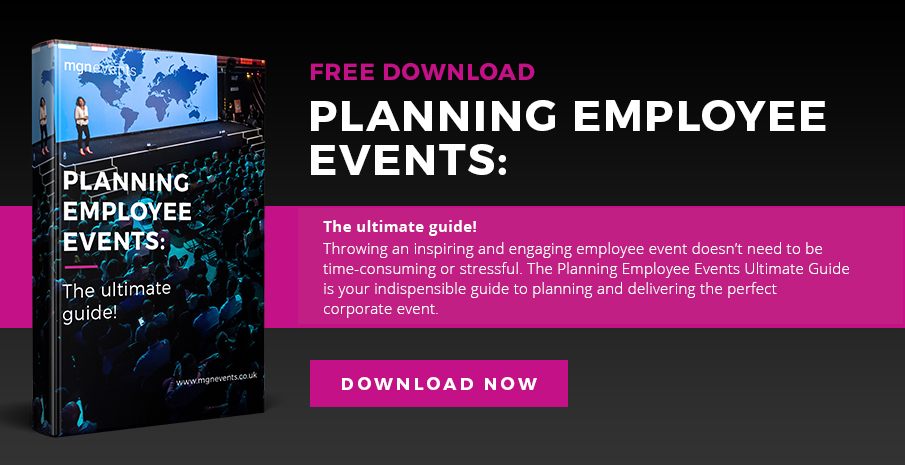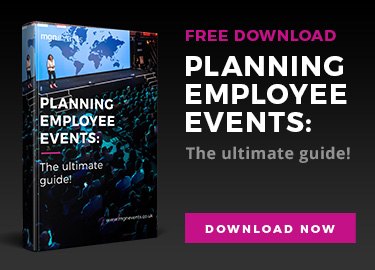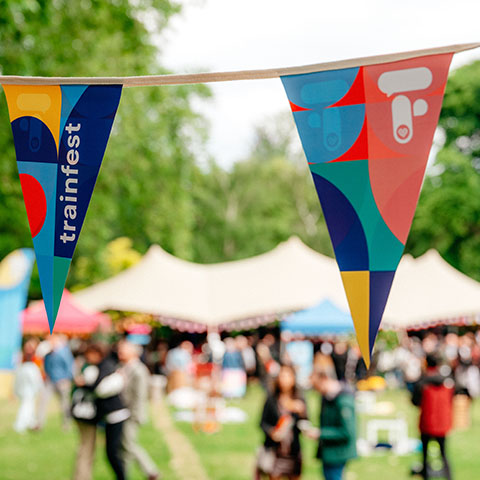Employers are becoming increasingly aware of the growing importance of staff well-being and the impact it has on the employee experience. This article explores the role of corporate events in improving staff well-being and provides a framework for internal event managers to follow.
This article is full of interesting insights and information relating the importance of staff well-being and how it can impact engagement, productivity and overall company performance.
However, if you’d rather jump straight to our five step framework, just click on the following links to find out more:
1. Identify event objectives
2. Create an engaging event
3. Promote staff well-being
4. Create two-way communication
5. Evaluate event success
Understanding the importance of staff well-being
Today’s modern workplace is evolving, with flexible hours and home working more commonplace than ever before. Despite this hybrid way of working, better technology is facilitating more collaborative working practices across teams who are expected to connect, communicate and deliver coherent results. In order to maximise these benefits, employers need to be open to change and willing to embrace these new ways of working. In doing so, they can expect to attract and retain top talent, enjoy better staff productivity and ultimately greater profitability and success.
Whilst this evolution in working practices can be a positive force for both employers and employees alike, change in itself can be difficult to implement and needs to be carefully and sensitively planned. Clear communication and employee well-being need to be considered at every stage. Indeed, a recent report by the Health & Safety Executive found that stress, depression, and anxiety accounted for 50% of all work-related cases of ill health in 2020/21.

In light of this, employers are becoming increasingly aware of the growing importance of staff well-being and the impact it has on the employee experience – which in turn affects the success of their organisation. Staff want to feel that the work they do is valued by others, but they also want to feel a sense of belonging, that their contributions are part of something bigger and more meaningful. They want to feel safe sharing their thoughts and ideas and have a say in how their organisation is progressing. Moreover, employees don’t want to sacrifice their mental or physical health for work and are looking for a better work-life balance.
Consequently, if organisations are truly able to create a culture in which employee well-being is at the heart of everything they do, they will reap the rewards in the form of higher staff productivity, employee engagement, and loyalty.
How Internal Events Can Drive Change
Enthusiastic, dedicated and motivated employees are much more likely to have better job performance and productivity than disengaged employees. However, according to analytics and advisory firm Gallup’s recent State of the Global Workplace report, only 15 percent of employees worldwide are engaged in the workplace. The situation is especially grim in the UK where the figure is as low as 8 percent.
Unsurprisingly, organisations are constantly looking for different ways in which they can solve the thorny issue of low employee engagement – and internal events can be part of the solution. In fact, when organised in the right way, internal events can be a very powerful tool for inspiring, educating and motivating employees, thus increasing a level of engagement across the board.
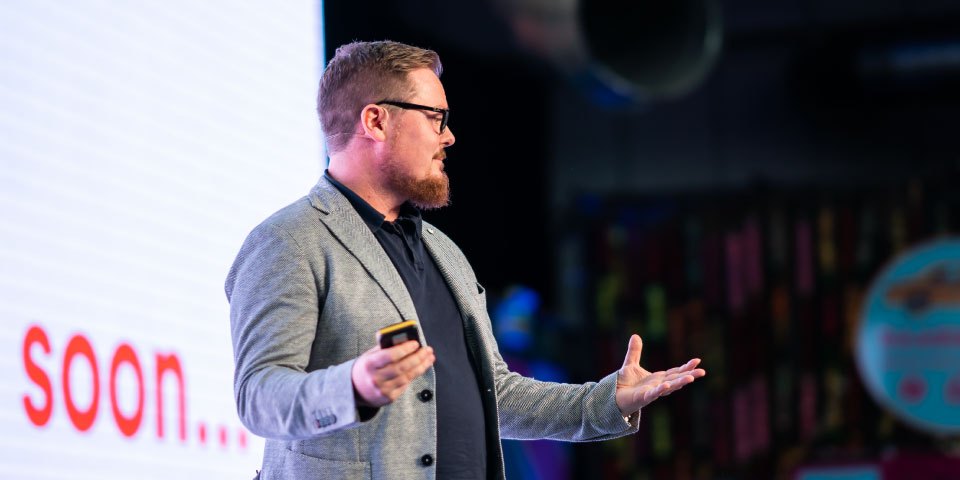
There are a whole host of internal events that can be put together to help boost staff well-being and increase engagement. For example, hosting company festivals in the summer, planning themed corporate away days and fun Christmas parties are just some of the ideas you may have considered for your next event.
However, there are some corporate events where consideration of employee well-being may be even more important due to their very nature. For example, events like AGMs, conferences and seminars can have heavy subject matter and are often long in duration, leading to information overload and fatigue for employees. As such, employee well-being and engagement is of utmost importance at these types of events and should be a serious consideration from the outset.
And if you still need some convincing about the power of internal events in levelling up the employee experience, here are some of the benefits to be experienced:
Improved communication
Sharing your company vision and values as well as updates on projects and goals is extremely important to help employees understand how their role fits into the bigger picture. This is especially true when sharing information about organisational change, such as implementing new technology or cost-saving measures. Events allow important communications and feedback to take place in real-time, so that every member of staff feels included and has a sense of belonging.
Creating a sense of togetherness
A well organised corporate event provides a great opportunity to bring employees together from different parts of an organisation providing valuable face time and opportunities to bond with one another that wouldn’t be possible in a remote setting – all of which contribute to a positive workplace culture.
Leveling hierarchy
Bringing together senior executives with the rest of employees in one space can have a really positive effect on staff morale – especially if the organisation is large and spread across different sites. Making senior managers more accessible and allowing employees to openly engage with them by sharing thoughts, ideas and even issues will create closer working relationships and a more positive environment for staff.
Greater staff well-being
Hosting internal events can help to enhance staff well-being in a number of different ways. For example, events that encourage the sharing of different perspectives, ideas and how to resolve issues help staff feel their input is valued. Moreover, enlisting their help in finding solutions to problems will help them take ownership of the outcome and they will feel more positive about change. Additionally, fun-filled events, such as summer parties and family fun days allow staff to let off steam and make them feel appreciated for their hard work.
The combined positive effects that internal events can bring to an organisation ultimately help to boost productivity and morale.
Our 5 step framework to internal event success
1. Identify event objectives
What is the reason for the event? What outcomes are you looking for? When does the event need to take place and why? For example, is your organisation rolling out a new product and needs to educate and inform staff about it? Or are things not going so great and staff morale needs a boost? If organisations truly want internal events to create positive and lasting change for all stakeholders, they need to ensure events are planned with a clear purpose in mind. Clarity around the ‘why’ of the event will make it a whole lot easier when planning the event, deciding how content will be delivered and how you will evaluate its success.
Moreover, if you have data to benchmark against, that will be very useful when evaluating the outcomes of the event. For example, if you know staff are currently feeling overwhelmed by an important big project or your company’s busiest sales season is coming up, what evidence can you gather from HR that will help you evaluate if your event has helped staff navigate these challenges?
2. Create an engaging event
The key to capturing mindshare at your event is to create unique experiences which engage , inspire and motivate employees. Think about the things that will have the greatest impact upon them, such as the location, format of the event, content delivery, technology, catering and the styling/décor. How can you design all of these elements so they come together seamlessly and provide talking points that will get people excited about not only attending but also sharing and promoting your event before, during and after.
Here are some of the ways in which you can create an engaging event:
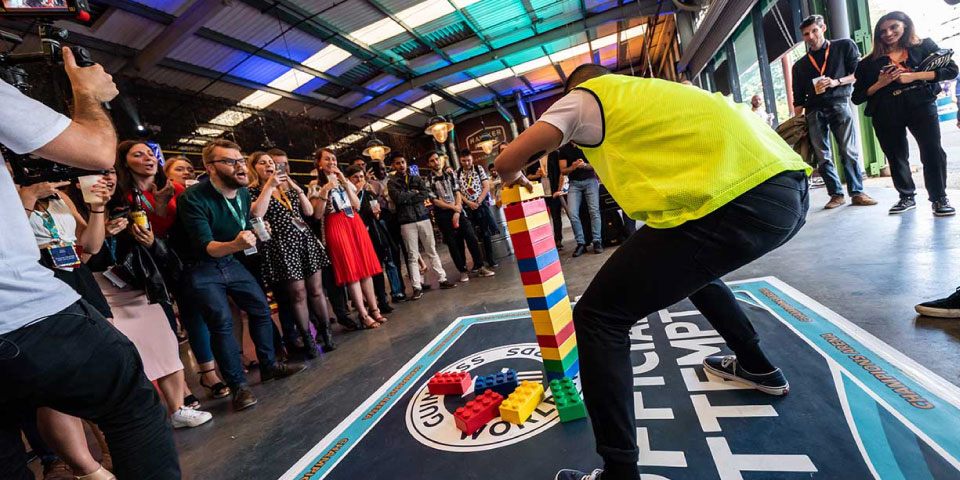
Incentivise employees
Time is a precious commodity and so you need to plan internal events that encourage high attendance and are worth the time of employees. You can do this by highlighting some of the exciting features of your event, such as a guest speaker or an unusual venue on the invitation marketing. You can also provide incentives, such as goodie bags, prizes on the day, delicious food and fun entertainment. Again, be sure to add these details to the invitation to keep employees engaged from the outset.
Unique venue
A fabulous venue that offers a different experience to typical conference halls or hotels can be a great way to create a buzz before your event even begins. Unique spaces such as iconic landmarks, urban rooftops, museums and even Concorde hangars can set the stage for an incredible event experience. Of course, you need both form and function; the venue might be stunning but it’s of no use if it doesn’t allow the different elements of your event to work well together.
“Unusual venues are great for creating memorable corporate events, but they aren’t always the easiest spaces to work with” explains Mike Walker of MGN events. “We’ve organised small intimate gatherings on Tower Bridge to large-scale parties in London for national brands like Trainline, so we know how to make every kind of space work.”
However, if your event is taking place in more of a traditional setting, think about how you can make it more interesting by segmenting the space. For example, creating different themes for different areas, such as coffee-shop style relaxed seating for break out discussions or interactive installations in the main program area to keep the energy alive.
Whichever venue you decide to go with, you need to find an event management company that has the expertise, creative vision and technical know-how to help you create a corporate event that has both staff and management raving about it for years to come.
Innovative content delivery
How content is delivered is just as important as the content itself. Nobody wants to sit for hours staring at boring PowerPoint presentations or be talked at by an endless procession of speakers. Content must be delivered in a way that makes people want to watch, listen, and participate otherwise the core message you’re trying to get across will be lost.
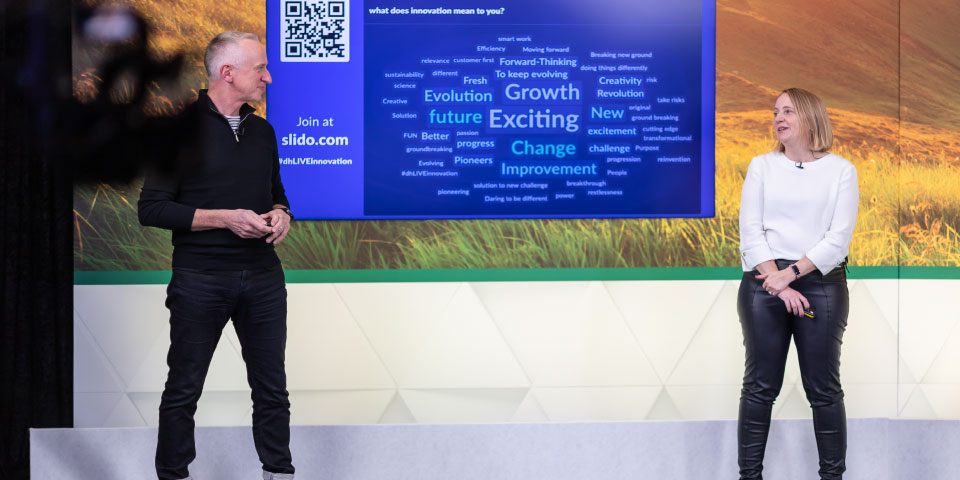
If your event needs to have the traditional format of speakers on stage, encourage those who are presenting to use a story-based framework to engage, inspire and motivate the audience. Storytelling is a powerful way of communication and one that’s rarely forgotten if done well.
Also think about bringing an interactive element to your event as this will increase levels of engagement and make things more fun and memorable for employees.
Depending on the event, you can mix things up by encouraging staff participation through things like live polls, quizzes, competitions, and challenges. These are also great ways to educate staff by including questions that relate to your company, products, and even fun facts about employees.
Implement technology
Using technology to add an immersive element to your event is a great way to increase staff engagement and create an altogether different experience. For example, installations like interactive touch video walls can bring presentations to life whilst multi-touch tables allow employees to learn and explore topics at their own pace. Virtual reality simulators can be used to visualise new products and showcase potential ideas. And to introduce an element of fun, digital graffiti walls and selfie walls are sure to get everyone excited.

“Lighting, sound and stunning visual effects to highlight key elements of your event are extremely important in ensuring your event has the greatest impact possible” explains Neil Walker, Production Director at MGN events. He’s been involved with some of the company’s most successful corporate events and is at the forefront of what’s possible from a technological perspective. “We work with some of the most prestigious brands in the world who expect the very best in innovative ideas for their events. From virtual reality simulators to projection mapping, logos and messages, we’ve done it all.”
And if you have a large number of employees spread out across different regions or even countries, live streaming of the event is a great way to connect and extend its reach. Amazing event photography as well as recording sessions for employees who can’t physically attend the event can ensure they don’t completely miss out on the experience.
3. Promote staff well-being
Staff well-being should be baked into your event right from the outset in order for it to feel genuine and authentic. As we have seen, corporate events are very important in helping to increase staff engagement, boosting morale and creating closer working relationships – all of which help to increase staff well-being. And so, it makes sense for the event itself to be planned in such a way to reflect this.
You need to look at all of the different ways you can introduce wellness elements into your event in a way that feels natural and authentic. Here are some easy ways you can ensure staff well-being is at top of the list when planning your next corporate event.
Relaxation sessions
Deep breathing, meditation and stretching all have their place in helping staff to release stress and feel more energised. Depending on the event, you can have longer, more dedicated sessions that people can opt to join in with. Alternatively, a simple 10-minute exercise in the middle of a seated program can work wonders to clear the mind and reset focus. And if you want to get people moving in a fun and lighthearted way, a motion reactive wall or dynamic floor could be the way to go!

Favourable schedules
Creating ‘breathing space’ in the event schedule will allow guests to experience everything at a gentle pace, without feeling harassed or rushed from one session to the next. If you’re providing lunch, allow ample time for staff to eat and also catch up with colleagues they haven’t seen in a while. If your event is running all day, be sure to include plenty of breaks where staff can hydrate, grab a healthy snack and visit the restroom.
Energising food and drink
Promote staff well-being by serving delicious, healthy and nutritious food and drink that energises guests and makes them feel good. You can go a step further by adding an experiential element that surprises staff and brings a smile to their faces. For example, edible mist orbs allow guests to inhale flavoured mists through a straw to get an instant zero-calorie flavour sensation.
Whatever menu you choose, be sure to cater for different dietary requirements where possible by surveying staff beforehand. This is especially important to do in order to find out crucial information regarding food allergies that may affect some staff. By asking beforehand, you’re clearly demonstrating to your staff that their well-being is a top priority.

Amazing ambiance
Creating the right ambiance and comfort level can greatly affect the mood of event attendees, yet this is something that can often be overlooked.
For example, the temperature inside the venue should neither be too hot or cold and there should be options to adjust it easily. If you have a large number of people in an enclosed space, you might need to consider using air purifiers to increase the quality of the air.
You can also use essential oil diffusers which help to calm, relax or energise staff depending on the time of day. Areas where staff register for the event are a great place to use these as they smell wonderful and set the right tone for the day. Similarly, plants and floral arrangements can really bring a space alive and create a wonderful mood boosting effect for staff.
Lighting is another factor which greatly affects the mood of an event. The right lighting can help staff feel calm and relaxed but shouldn’t make them feel sleepy!
4. Create two-way communication
Although communicating key messages, values and goals to employees is important at internal events, organisations also need to demonstrate they are actively listening to their employees and taking their ideas, issues and concerns seriously. And so, depending on the type of event you’re planning, you’ll need to make sure you have a system in place to gather staff feedback and also prove how that information will be used to create positive outcomes for staff and the organisation as a whole.
As we have seen earlier, technology can be used to create impactful experiences at corporate events, but it can also play a role in measuring staff satisfaction and engagement – even during the actual event. “We can perform real-time surveys during events to find out what your audience is thinking and feeling during the event” says Neil Walker. “Our live response tools significantly improve audience participation which is key to collecting data that can be used in a meaningful way.”
One of the key questions that leaders will no doubt want to know is if their employees feel differently about the organisation as a result of the experience they’ve had during the event? And whilst promoting staff well-being is more of a medium to long-term strategy, initial event feedback is really important in terms of informing new workplace policies and future corporate events.
5. Evaluate event success
The success metrics you use to evaluate your event should be agreed upon at the planning stage and will be directly linked to the objectives of the event. Indeed, different organisations will have different measures of success depending on many different factors. For example, an organisation that’s suffering from poor morale might consider a 75% attendance rate at their next corporate event a huge success.
Moreover, the success of any corporate event (no matter which metrics you use) should always tie into bigger organisational objectives over the long-term. Rarely will one event solve a problem or create lasting change; internal events and the objectives behind them are part of an ongoing journey to improve staff well-being, organisational culture and the employee experience, which ultimately leads to a more productive and successful organisation.
Conclusion
A successful corporate event must always have the interests and well-being of staff at the very heart of it – whether you’re planning a conference, an intimate team-building event or an epic Christmas party extravaganza. And as we have seen, there’s a great deal of planning and effort required to design and implement activities that create an amazing event experience for staff.
Moreover, expectations from senior leaders and employees are likely to be very high if the event is on a large scale, celebrating an important milestone and/or has a considerable budget attached to it.
So if you’re planning an important event in the corporate calendar, consider working with a specialist events management company that can bring years of experience as well as a valuable outside perspective to your event. This is especially important if you’re tackling a new objective or looking for a positive ROI from the event.
Contact the team at MGN events to discuss how we can help you ensure that staff well-being is integral to your next corporate event. You can contact our team either via the form below, on 01932 22 33 33 or by email hello@mgnevents.co.uk.

